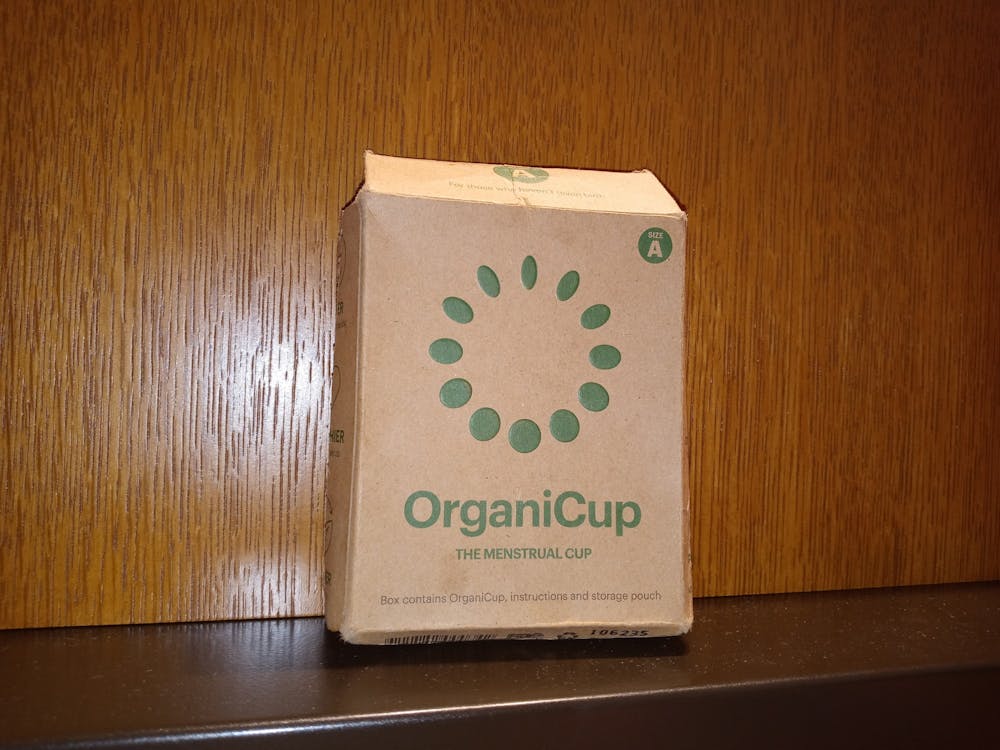The following is a guest contribution from the University’s Menstrual Products Task Force and reflects the authors’ views alone.
The Menstrual Products Task Force wants to share with you the variety of menstrual products that exist in the market today, as many new products have emerged. With periods remaining an extremely stigmatized and sensitive topic, and traditional disposable tampons and pads holding a monopoly in menstruation space, it can be hard to learn about the newer products that exist. We hope that these options present alternatives that best fit your needs as a menstruator!
We evaluated seven different types of menstrual products on sustainability, price, accessibility, and comfort. In looking at sustainability, we considered carbon offsets, reusability, and the product materials.
Disposable Pads
As one of the most common types of menstrual products, disposable pads dominate the market, coming in a variety of absorbencies, shapes, and sizes. Attached to the underwear of the menstruator, pads absorb the flow. While many find them bulky, pads have been more recently designed to provide comfort while maintaining high levels of absorbency, responding to this popular criticism. Commonly assumed to be made of cotton, most pads actually contain a blend of different plastics to achieve durability, absorbency, and limited visibility. In addition, most pads are individually wrapped in plastic for sanitary purposes. Typically lasting between six to eight hours, pads tend to be relatively higher maintenance compared to the other options on this list. However, they remain one of the more accessible menstrual products in terms of price.
Price: $5.49 for 40 pads
Sustainability: Disposable and filled with plastics/wrapped in plastics; as medical waste, cannot be recycled.
Overall: While this is not the most sustainable option, it does have a higher durability and absorbency.
Tampons (plastic, cardboard, no applicator)
The modern tampon design is fairly similar across different brands. The tampon is usually made of some absorbent material — primarily cotton or rayon, which is a synthetic fiber. The shape of the tampon is also crucial in its function, as it takes the form of a cylindrical barrel with a string attached at the bottom. Reusable products are becoming more commonplace and widely adopted. This sustainable attitude has also penetrated the period product sphere as manufacturers are discovering innovative ways to reduce their carbon footprint. For example, tampons with a cardboard applicator tend to have a similar design to those with a plastic applicator but are considered more environmentally-conscious due to their biodegradable nature. Some companies produce tampons which are made from 100 percent cotton and are completely biodegradable — from wrapping to delivery boxes, everything is recyclable.
Price: $7 for 36 tampons
Sustainability: This depends on the brand and how biodegradable the tampons are (look for cardboard applicators and recyclable packaging/wrapping).

Overall: While the degree of sustainability is dependent on the brand, the tampon is generally absorbent and portable due to its small size.
Menstrual Cups
Whether you are looking to help protect the environment or your wallet, a menstrual cup is a wonderful option for menstruators. Unlike pads or tampons that absorb your flow, the menstrual cup is a silicone or plastic small cup that collects flow when inserted. Despite a higher initial cost of $10–$40, a menstrual cup typically lasts six months to two years because they are reusable. This allows users to reduce their waste and costs over time. The health effects are similar to any menstrual product requiring insertion, such as a tampon, with even fewer concerns about pH due to the sealed nature of the product. You can also leave in a cup for eight to 12 hours, which is great for overnight usage and hectic days. There is a bit of a learning curve with inserting, removing, and cleaning the product, but there are a ton of resources available online to become more familiar with all of this!
Price: Varies $10–$40, lasting from six months to years
Sustainability: With a lifespan of six months to two years, these are one of the most sustainable products on the market.
Overall: Not only are these products sustainable and long-lasting, one can also leave in a cup for eight to 12 hours, thus reducing the need to change or remove.
Menstrual Discs
Menstrual discs are disposable, insertable round discs that provide about 12 hours of protection for menstruators. They have been recently growing in popularity because they allow menstruators to have mess-free sex on their period and can help minimize cramps. Like menstrual cups, discs are meant to collect blood instead of absorbing the flow. However, discs sit in the vaginal fornix (the base of the cervix) instead of the vaginal canal like a cup, meaning they go in deeper than the cup. The disc stays in place by expanding into the largest part of the vagina, sitting behind the pubic bone, so there is no suction involved. Menstruators should not feel the disc inside of them. Each disc holds the equivalent of five regular tampons. Since one needs to change them every 12 hours and can dispose of them directly after removal, they are a relatively low maintenance option. However, they are often made up of body-safe polymers (plastics) that are not meant to be reused. Therefore, they are not the most sustainable option on the market.
Price: $12 for 14 discs
Sustainability: Since there is not a ton of packaging and fewer actual products are used, they are more sustainable than traditional pads and tampons. But they are still disposable.
Overall: While these products are more sustainable than the traditional pad or tampon, they may be slightly more uncomfortable due to their positioning within the body. This being said, they do help reduce menstrual cramping and are more absorbent than the tampon.
Reusable Pads
A variation on the more common disposable pads, reusable pads provide an alternative method to externally absorb any flow. Often coming in one or two parts, reusable pads snap around the user’s underwear and are available in various shapes and sizes. Levels of absorbance can also vary between pads while generally providing greater absorption than disposable pads. Although the environmental difference between disposable and reusable pads is not clear, less waste is created given that pads last up to five years and cleaning entails a quick rinse and wash before sticking them in the laundry with the rest of your clothing. Users of reusable pads may also be more confident in the materials being used, compared to disposable pads.
Price: Varies $14–$26 for one
Sustainability: As the name suggests, reusable pads create less waste than traditional pads due to their longer lifespan.
Overall: In comparison to disposable pads, reusable pads disclose all chemicals present in the product and can be used for longer periods of time. There is a higher initial cost, but the long-term value makes it a better choice than disposable pads.
Period Underwear
Period underwear is exactly what it sounds like: underwear that is meant to absorb flow. Absorbency levels vary across brands. One brand, Thinx, advertises that their period underwear can hold five tampons’ worth of flow. Coming in many different styles, period underwear can serve as a complete replacement for other menstrual products or as a supplement. A plus is that it is very easy to care for; it can be thrown into the washing machine with the rest of your laundry (machine wash cold), then hung up to dry. Lasting about two to five years, they are also very comfortable compared to pads and tampons — wearing them feels like wearing any other piece of underwear because they are made out of moisture-wick cotton.
Price: Varies $20-$40 for one
Sustainability: This depends on whether it is used as a complete replacement for disposable products, but the product itself is very sustainable considering its reusability.
Overall: Since menstruators need around five to use this as their sole period product, the price point is on the higher side ($100-$200 for five), but nonetheless pretty sustainable and long-lasting.
Menstrual Sponge
Imagine a renewable tampon that is completely biodegradable. Welcome to the world of the menstrual sponge. Often harvested naturally (although synthetic versions are also available), menstrual sponges are worn internally to absorb any flow. Sponges can be worn for up to eight hours and last for around six months. Unlike other products, sponges can be trimmed and insertion techniques vary from user to user. While sponges do a great job at absorbing your flow, taking them out can be a little messy and cleaning before and after use requires some attention.
Price: $30 for two
Sustainability: As the only biodegradable option (if using a natural sponge) on the market, they are very sustainable!
Overall: The sponge is not super well-known/accessible. However, they can be worn for long periods of time for those who are unable to remove/insert at period intervals during the day.
The Menstrual Products Task Force is a USG Task Force dedicated to getting free menstrual products access in campus restrooms. We understand the need for these products presents a financial burden for a sizable portion of our student body and not having access greatly impacts student health, dignity, and academic success. We would love to hear from you if you have any questions, concerns, or suggestions about menstrual products, the work that we do, or what you would like to see from us in the future! Reach out to us at mpatprinceton@gmail.com or email our Director, Rayyan Sarker ’22, at rsarker@princeton.edu.








